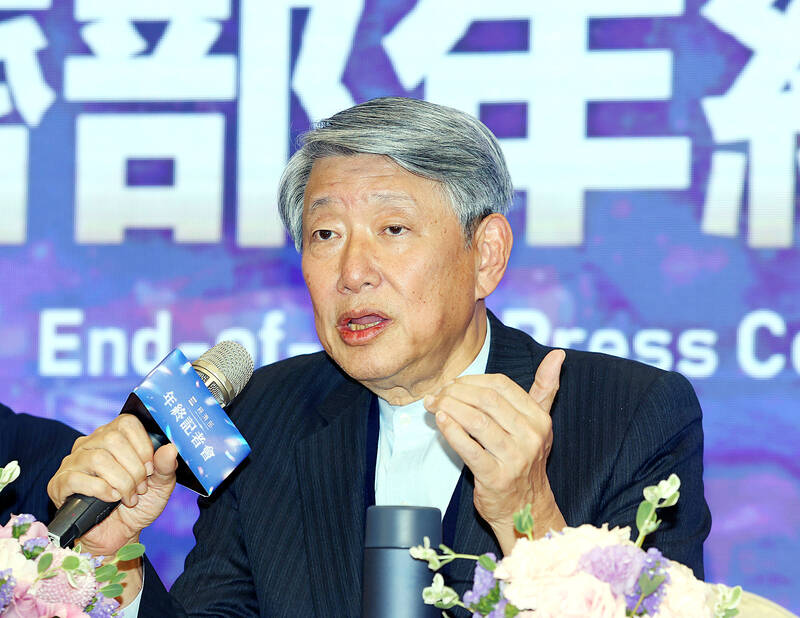Taiwan Semiconductor Manufacturing Co (TSMC, 台積電), a major chip supplier to Nvidia Corp, would no longer be restricted from investing in next-generation 2-nanometer chip production in the US, the Ministry of Economic Affairs said yesterday.
However, the ministry added that the world’s biggest contract chipmaker would not be making any reckless decisions, given the weight of its up to US$30 billion investment.
To safeguard Taiwan’s chip technology advantages, the government has barred local chipmakers from making chips using more advanced technologies at their overseas factories, in China particularly.

Photo: CNA
Chipmakers were previously only allowed to produce chips using less advanced technologies, specifically those that were at least two generations less advanced than those being used domestically, it said.
“Those were old-time rules. Times have changed,” Minister of Economic Affairs J.W. Kuo (郭智輝) said on the sidelines of a ministry media briefing yesterday.
“Private businesses should make their own business decisions based on their own technological progress,” Kuo said.
“The basic principle is that businesses can make profits from their overseas investments,” Kuo said. “TSMC is building factories in the US with the aim of serving its US customers, as 60 percent of the world’s chip-designing companies are based in the US.”
TSMC would “cautiously” evaluate the possibility of investing in building a 2-nanometer fab in the US, which would cost US$28 billion to US$30 billion, Kuo said, adding that TSMC would not yield under pressure from the incoming US government, or rush to build such an advanced chip manufacturing fab in the US.
TSMC has said its second fab in Arizona would produce chips using 2-nanometer and 3-nanometer technology in 2028, after the first fab begins production of 4-nanometer technology in the first half of this year.
The third fab would produce chips using 2-nanometer or more advanced processes, with production beginning by the end of the decade. The investment in Arizona would surpass US$65 billion, it said.
The ministry’s top priority this year is to build a global semiconductor supply chain in collaboration with the US, Germany, Japan and the Philippines, Kuo said.
In Japan, the ministry plans to create an office in Fukuoka, which is about a two-hour drive from Kumamoto, where TSMC is building two chip factories, to assist local semiconductor-related companies in setting up operations in Japan, Kuo said.
The ministry is set to sign an agreement with a private organization on behalf of the Japanese government in the first quarter or second quarter to safeguard Taiwanese companies’ interests, he said.
Commenting on the impact of possible changes in US trade policy, Kuo said the new tariffs proposed by US president-elect Donald Trump would have a relatively minor impact on Taiwanese exporters and export orders, given their strong technological capabilities.
Export orders this year might grow compared with last year, particularly as local companies benefit from the US-China trade row, he said, adding that domestic manufacturers are replacing their Chinese counterparts in supplying goods to US companies, while also allocating more production back to Taiwan, he said.
“Trump will only be in office for four years and can’t run for another term so his impact will be limited,” Kuo said.
Additional reporting by Bloomberg

CHIP RACE: Three years of overbroad export controls drove foreign competitors to pursue their own AI chips, and ‘cost US taxpayers billions of dollars,’ Nvidia said China has figured out the US strategy for allowing it to buy Nvidia Corp’s H200s and is rejecting the artificial intelligence (AI) chip in favor of domestically developed semiconductors, White House AI adviser David Sacks said, citing news reports. US President Donald Trump on Monday said that he would allow shipments of Nvidia’s H200 chips to China, part of an administration effort backed by Sacks to challenge Chinese tech champions such as Huawei Technologies Co (華為) by bringing US competition to their home market. On Friday, Sacks signaled that he was uncertain about whether that approach would work. “They’re rejecting our chips,” Sacks

NATIONAL SECURITY: Intel’s testing of ACM tools despite US government control ‘highlights egregious gaps in US technology protection policies,’ a former official said Chipmaker Intel Corp has tested chipmaking tools this year from a toolmaker with deep roots in China and two overseas units that were targeted by US sanctions, according to two sources with direct knowledge of the matter. Intel, which fended off calls for its CEO’s resignation from US President Donald Trump in August over his alleged ties to China, got the tools from ACM Research Inc, a Fremont, California-based producer of chipmaking equipment. Two of ACM’s units, based in Shanghai and South Korea, were among a number of firms barred last year from receiving US technology over claims they have

It is challenging to build infrastructure in much of Europe. Constrained budgets and polarized politics tend to undermine long-term projects, forcing officials to react to emergencies rather than plan for the future. Not in Austria. Today, the country is to officially open its Koralmbahn tunnel, the 5.9 billion euro (US$6.9 billion) centerpiece of a groundbreaking new railway that will eventually run from Poland’s Baltic coast to the Adriatic Sea, transforming travel within Austria and positioning the Alpine nation at the forefront of logistics in Europe. “It is Austria’s biggest socio-economic experiment in over a century,” said Eric Kirschner, an economist at Graz-based Joanneum

BUBBLE? Only a handful of companies are seeing rapid revenue growth and higher valuations, and it is not enough to call the AI trend a transformation, an analyst said Artificial intelligence (AI) is entering a more challenging phase next year as companies move beyond experimentation and begin demanding clear financial returns from a technology that has delivered big gains to only a small group of early adopters, PricewaterhouseCoopers (PwC) Taiwan said yesterday. Most organizations have been able to justify AI investments through cost recovery or modest efficiency gains, but few have achieved meaningful revenue growth or long-term competitive advantage, the consultancy said in its 2026 AI Business Predictions report. This growing performance gap is forcing executives to reconsider how AI is deployed across their organizations, it said. “Many companies